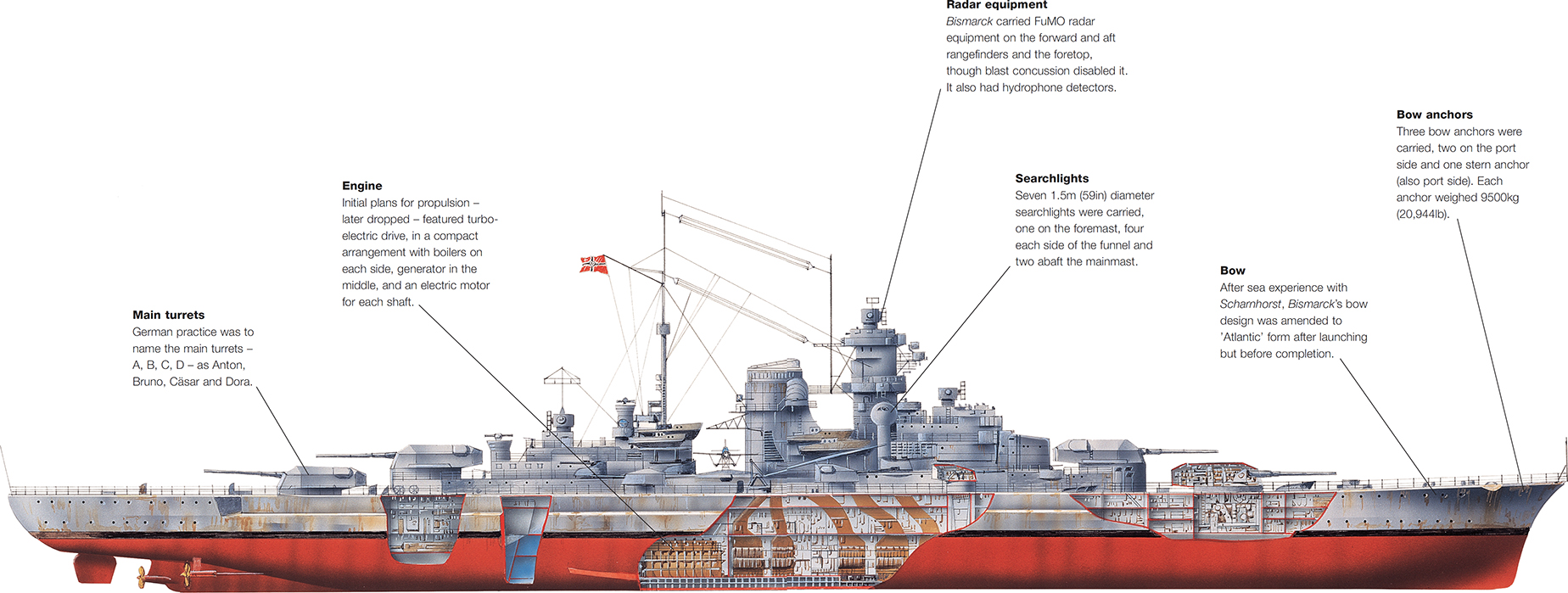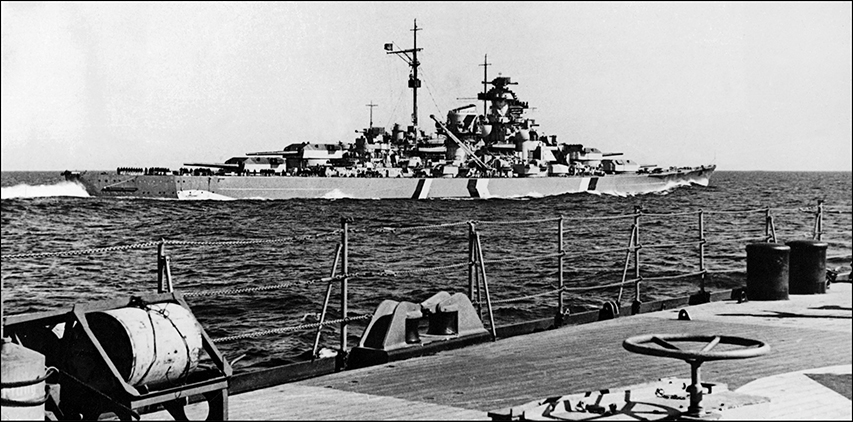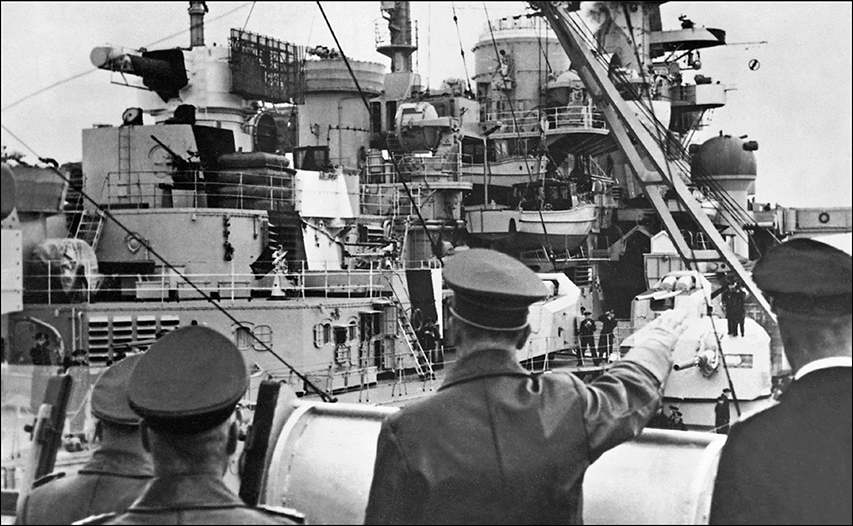 Bismarck (1940)
Bismarck (1940) Bismarck (1940)
Bismarck (1940)Bismarck and Tirpitz represented the peak of German battleship design – in terms of size, armament, speed and staying-power. But Bismarck’s first combat mission, though including a major success, was also its last.
While Adolf Hitler contemplated a war against Great Britain, he told his naval chiefs that it would not be until 1944–45, and when war actually broke out in September 1939 the Kriegsmarine had only two modern battleships plus four ‘pocket battleships’. But two very large warships had been launched, and two even larger ones had just been laid down (though their construction was abandoned at the end of 1942).
Bismarck was laid down at Blohm & Voss, Hamburg, on 1 July 1936, launched on 14 February 1939 and completed on 24 August 1940. Its cost was 196,800,000 Reichsmarks. The chief designer, Dr Hermann Burkhardt, who was also responsible for Gneisenau and Scharnhorst, was no longer operating within constraints other than the essential considerations of balancing firepower, speed, protection and propulsive power. The main guns were eight 380mm (15in) mounted in twin turrets, arranged to keep the guns as far apart as possible to avoid shocks and interferences.

The cutaway plan gives some idea of the extent and subdivision of internal compartments within the hull. This arrangement was one of prime reason’s for the ship’s remarkable staying-power in combat.
Barrel length was L/47 and weight was 97.5 tonnes (107.5 tons). Range was 36,200m (39,589yd) at an elevation of 35 degrees (giving a low trajectory and shortening shell flight time). The shells weighed 798kg (1759lb) and were of three kinds: armour-piercing HE for use against battleships and two types of HE shell, one with a head fuse and one with a base fuse. Identical guns were fitted on Tirpitz – 12 140mm (6in) guns fitted in twin turrets, three on each side. AA defences consisted of 16 105mm (4.1in) twin-mount guns, 16 37mm (1.5in) twin-mount and 12 20mm (0.79in) single-barrel guns.
Gunnery control was located in three positions, on the forward conning tower, above the foretop platform and on the rear conning tower, with communication links to two computation rooms, within the armoured zone fore and aft. Unlike Tirpitz, Bismarck carried no torpedoes but both ships had four Arado Ar196 floatplanes. The hull was constructed from ST52 steel and more than 90 per cent was of electric welding construction. Armour was of three kinds, Krupp KCn/A face-hardened for the belt, turrets and control towers; Wh – Wotan hart (‘hard’) – for the armoured decks, and Ww – Wotan weich (‘soft’) – for the longitudinal torpedo bulkheads.
Altogether the armour weight was 15,654 tonnes (17,256 tons), 32.2 per cent of total displacement. The hull was divided into 22 watertight compartments, 17 within the armoured zone which accounted for 70 per cent of the ship’s waterline length. From foretop to keel were 17 levels or decks. In total 12 high-pressure boilers in six watertight compartments supplied steam to three Blohm & Voss turbine sets, each in separate rooms and driving the three screws. Eight 500kW diesel generators, five 690kW and one 460kW turbo-generators were installed in four plants. In terms of internal layout, levels of protection and capability in action, this was the most effective battleship yet built.
Specification
Dimensions |
Length 251m (793ft), Beam 36m (118ft), Draught 9.3m (31ft), Displacement 37,194 tonnes (41,000 tons); 44,905 tonnes (49,500 tons) full load |
Propulsion |
12 Wagner HP boilers, 3 Brown-Boveri geared turbines developing 111,982kW (150,170hp) |
Armament |
8 380mm (15in) guns, 12 150mm (5.9in) guns, 16 105mm (4.1in) guns, 16 37mm (1.5in) guns, 12 20mm (0.79in) AA guns |
Armour |
Belt 320–80mm (12.6-3.1in), Bulkheads 220– 45mm (8.6–1.7in), Deck 120-80mm (4.3– 1.7in), Barbettes 340–220mm (13.4–8.6in), Turrets 360–180mm (14.2-7in) |
Range |
16,430km (8870nm) at 19 knots |
Speed |
29 knots |
Complement |
2092 |
Under the name of Operation Rheinübung, Bismarck and Prinz Eugen left Gdynia on 18 May 1941 to raid merchant shipping routes in the Atlantic, with Admiral Günther Lütjens in overall command. It was a carefully planned mission, with supply ships and scouting U-boats in position. News of the departure reached the British from Sweden and from Norwegian resistance observers, and cruisers were deployed to keep watch while an interception force was mobilized.
On 24 May the battlecruiser HMS Hood and battleship Prince of Wales engaged the German ships, and Hood was sunk by Bismarck’s fifth salvo. Hits by three 356mm (14in) shells from Prince of Wales had done comparatively little damage to Bismarck. A huge three-day search and pursuit followed, with some 48 ships involved, including five battleships, two aircraft carriers, nine cruisers and 18 destroyers. Prinz Eugen reached Brest safely but Bismarck, after almost succeeding in dodging the pursuit, was hit by Swordfish torpedo bombers from HMS Ark Royal at 20:47 on 26 May, jamming the port rudder at 120 degrees to port.

Bismarck photographed from Prinz Eugen, en route to the Atlantic, 19–20 May 1941. The camouflage paint represents a false bow and stern, to minimise the ship’s great size.
Steaming through the night at only 18.5km/h (10 knots), Bismarck kept up a vigorous defence against by destroyers and from the air. On 27 May at 08:47 the battleships HMS Rodney and King George V opened fire at around 20,000m (21,900yd), gradually closing to 7860m (8600yd). By around 10:00 all Bismarck’s guns were disabled and the order was given to scuttle. Hit by more British torpedoes, it capsized and sank at 10:39 with 1977 of the 2221 people on board.

Adolf Hitler inspects the almost-completed Bismarck at the Gotenhafen (Gdynia) naval base on 5 May 1940.
Bismarck resilient
Despite the prolonged and ferocious pounding by 408mm (16in) and 356mm (14in) guns and numerous torpedo strikes, neither the armoured belt nor the armoured deck of Bismarck had been penetrated, apart from a single 356mm (14in) shell that penetrated the side armour. The one fatal strike was that of the aerial torpedo which jammed the port rudder, preventing the ship’s run for port. With the ammunition exhausted and its guns out of action, the crew were preparing for the ship’s self-destruction when three torpedoes from the cruiser HMS Dorsetshire struck the armoured hull. At first the British believed that these had finally sunk Bismarck, but all the battleship’s internal equipment continued to operate, including the engines. Had the war begun in the year Hitler had first envisaged, allowing another five years of German naval preparation resulting in a further six battleships of Bismarck standard, the war at sea would have been very different.